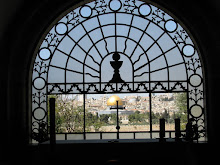As part of my research work I was in the Weizmann Institute of Science for 2 days. If you remember my earlier posts, I had snaps and details of the Weizmann Institute. This time I visited the Weizmann's house and the other monuments associated with his life. Chaim Weizmann (1874-1952) was the first president of Israel and a leading figure in the ideology of Zionism. Although he is a politician of legendary status in Israel, it was his strong scientific background that paved the first step to the formation of modern Israel.
A young scientist whose break-through technology defends a nation in a World War and acts as a catalyst for another nation to emerge from ashes after 2000 years. Does that appear to you somewhat like a fairy tale? The journey of Weizmann from a biochemist in the Manchester University, UK to the first president of Israel has a similar context. During World War I, Britain was facing shortage of the explosive cordite which was used for rifle bullets and artillery projectiles. The major ingredient for making cordite was acetone and which in turn was manufactured by distillation of wood. The inadequate supply of cordite during that wartime was due to the lack of acetone. In 1912, Weizman, developed a fermentation process using Clostridium acetobutylicum (also known as Weizmann's organism) to produce acetone from maize, a discovery that extensively resolved the crisis. His research and philosophy triggered the growth of the fermentation industries. No doubt why he is considered as the father of industrial fermentation.
Who could have thought this invention would dramatically change the politics of the Middle East region forever? After the war, when Britain wanted to honour Weizmann for his contribution, he declined any such idea, but instead requested for the need to gather his people from the ends of the earth. It was a request for a home to his people in the land of their ancestors. As a result, the idea of a Jewish homeland in Palestine was assured by the British Foreign Secretary, Earl Balfour. That event led directly to the milestone Balfour Declaration of 6 November 1917, which recognized Palestine as a ‘national home' for the Jewish people for the first time after 2000 years, and ultimately to the proclamation of the State of Israel with Chaim Weizmann as its first President in 1948! As a pioneering biochemist and a former student of Louis Pasteur, he has published some 100 scientific papers and was awarded, alone or jointly, some 110 patents. His work on the acetone-fermentation process is in fact one of the earliest examples of what came to be known as biotechnology.
Thursday, May 22, 2008
Weizmann Institute of Science Revisited (20-21 May, 2008)
Subscribe to:
Post Comments (Atom)

No comments:
Post a Comment